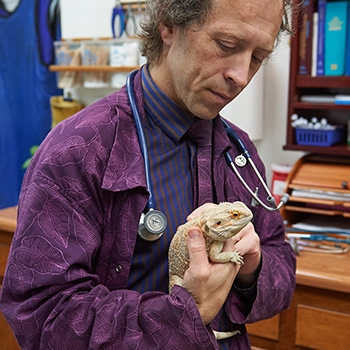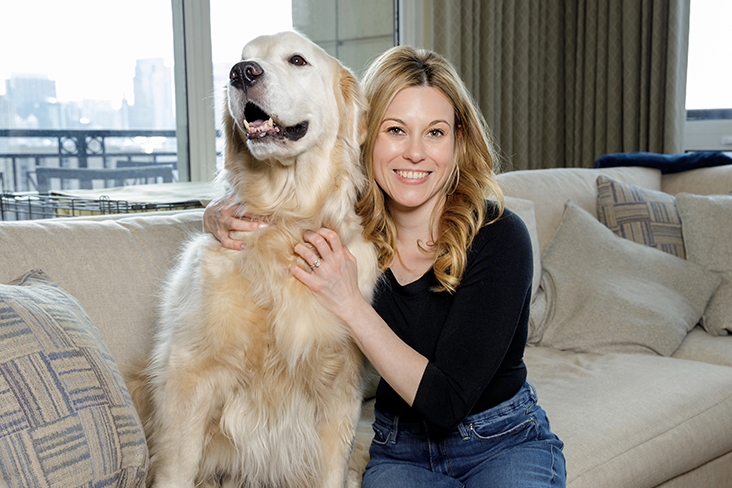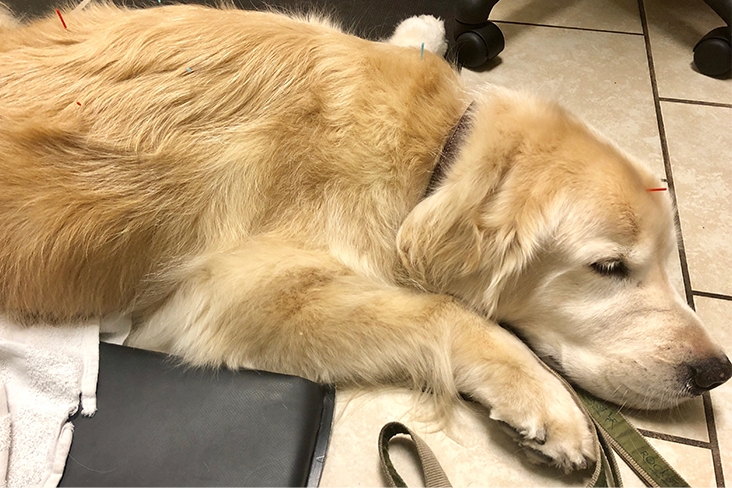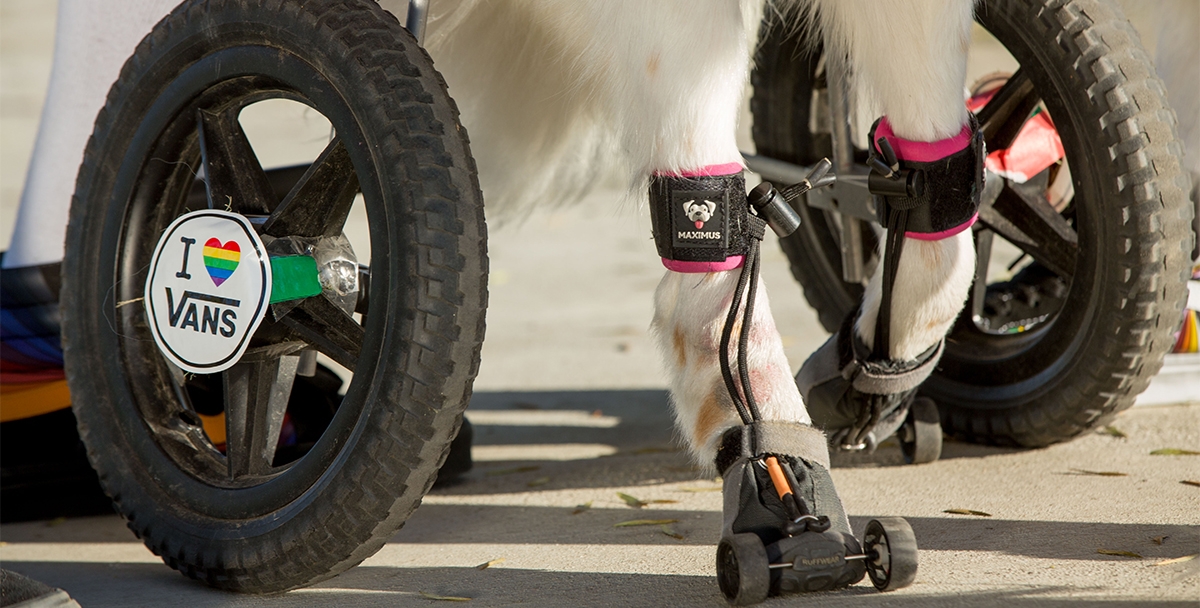My dog, Luna, a 6-year-old black Labrador/blue heeler mix with white patches on her chest, pulls ahead of me, tugging at the leash. We approach the Wise & Wonderful Integrative Veterinary Center on a quiet intersection in Santa Rosa, California, for Luna’s first appointment.
Luna hates the vet, but since this is a new clinic, she has no idea what to expect. She sniffs a German shepherd on his way out the door. All good. But once inside, Luna becomes suspicious, giving me a look like this better not be the vet. The waiting room smells like essential oils, and there’s a Gandhi quote on the wall.
“Hi, pretty Luna,” the woman behind the front desk says as Luna avoids eye contact. She takes us back to the patient room and asks me about Luna’s diet. Does she take fish oil? Supplements? No and no.

As an integrative clinic, Wise & Wonderful combines Western medicine – vaccinations, surgeries, medication – with holistic treatments derived from Eastern medicine, including herbal supplements, acupuncture and meal plans focused on fresh, whole foods.
Practices such as this began dotting the United States in the 1980s, drawing devotees, skeptics and, in the middle, a lot of pet owners who didn’t think much either way about what was often called “alternative care.” Today, there are thousands of integrative veterinarians in the country and many more pet owners who are curious about holistic methods.
Replacing bagged or canned food with freshly made meals, in particular, is having a moment: Retail store sales of fresh pet food increased 70% between 2015 and 2018 in the U.S., according to a Nielsen survey. Interest in pet acupuncture is also on the rise.
Dr. Judy Morgan, an integrative vet in Pennsville, New Jersey, says when she opened her first practice in 2001, she was the only one in the area offering acupuncture. These days, every veterinary clinic in the region offers it.



Luna and I are here at Wise & Wonderful to see if integrative pet care is for us. My husband and I adopted Luna four years ago, and we’ve done (and will continue to do) all the recommended conventional care, including vaccinations, spaying, heartworm medication, and flea and tick prevention.
She’s a healthy dog overall, but she suffers from anxiety – especially around strangers – and for no logical reason, around my kind, gentle brother-in-law who loves dogs and is often at our house. Maybe there’s a holistic solution, in addition to training, that could help.
On Pins and Needles
Erin Clifford, an attorney and wellness coach in Chicago, had been going to acupuncture appointments for years. Still, she never thought about acupuncture for her golden retriever, Gatsby.
Then, at age 8, Gatsby began limping and having mobility issues. Clifford’s vet diagnosed the issue: herniated discs in Gatsby’s back. Surgery was an option, but there was only a 50-50 chance that it would help, the vet told Clifford. It would also be expensive, costing anywhere from $1,000 to $4,000.

The other option was a combination of physical therapy and acupuncture. “When they suggested acupuncture, I thought, It works for me, why not try it for him?” Clifford says. As in humans, the ancient practice can help alleviate pain, relax muscles and improve mobility in pets.

At $80 a session, acupuncture also seemed more manageable financially. Gatsby was confused by the needles at first, but he soon relaxed and fell asleep. “I held a frozen peanut butter and yogurt treat for him while the needles went in, and he lay there for 20 to 30 minutes like a person would,” says Clifford.
“Afterward, he was totally energized. He was like a new dog.” Today, at nearly 12 years old, Gatsby is mobile and active, and his herniated discs bother him only occasionally, in the winter. “It’s been a lifesaver,” Clifford says.
Fresh Food Options for Pets
Some fresh-food brands, such as Freshpet®, are sold in the refrigerated section of the grocery store, but several start-ups, including Pet Plate, NomNomNow® and The Farmer’s Dog, are customized for your dog’s size, breed and activity level. (NomNomNow also has an option for cats.) Delivery costs vary based on the size of your dog and can range from $15 a week for a small dog to around $60 a week for larger breeds.
Vets have mixed opinions on nixing kibble. Dr. Marge Lewter, an integrative veterinarian in Blacksburg, Virginia, says a fresh-food diet can lower the risk of obesity and prevent future health problems. “Most commercial dog food is at least 50% carbohydrates,” she says, a number she finds too high. “A carb-loaded diet is inflammatory and not the healthiest over a lifetime.”
On the flip side, trendy grain-free formulas may not be the best option. The Food and Drug Administration recently issued an alert, still under investigation, linking 16 grain-free dog food brands to heart disease. Fresh food, Lewter says, can strike a balance. (Note that fresh still means cooked; the American Veterinary Medical Association advises against raw food diets.)
Other vets worry that by switching to fresh food, you may be unintentionally shorting your pup of key nutrients. Long-established brands, they argue, are backed by decades of research.
Many point to a happy medium: replacing a portion of kibble with fresh ingredients. A Purdue University study on Scottish terriers found that adding fresh vegetables, such as leafy greens and carrots, to the dogs’ diet at least three times a week decreased the risk of developing bladder cancer.
Curious, I ordered a fresh food brand for Luna to try, and I’ve been replacing a third of her kibble with it (a ratio recommended by Morgan). It may take a while to see any health benefits, but she seems to love it, giving us full-body tail wags in appreciation.
Do Pets Need Supplements?
U.S. consumers spent a record $636 million on pet supplements in 2018, according to market research firm Packaged Facts, with about 78% of those sales invested in dogs. Clifford gives Gatsby supplements of glucosamine, a compound found in cartilage, to help with joint pain.
Studies on the efficacy of glucosamine by itself have generated mixed results, but multiple clinical trials looking at dogs with osteoarthritis have shown a statistically significant reduction in pain after two to three months of taking supplements of glucosamine and chondroitin sulfate, another compound found in cartilage.
It’s important to go through a trusted vet for any pet supplements, says Lewter, as many products sold online aren’t regulated. Without professional guidance, supplements could cause stomach pain or worse. And, again, don’t skip crucial care like vaccines, heartworm medicine, or flea and tick control, she says.
Back at the Wise & Wonderful clinic, veterinarian Dr. Starfinder Stanley walks in wearing a cat sweater. He asks about my parenting style with Luna and sits on the floor to be at her level, even though she still won’t make eye contact.
He says Luna isn’t a good candidate for acupuncture, since her skittishness could affect needle insertion. Instead, he recommends Shen Calmer, a blend of 16 Chinese herbs to help with nervousness, or a pheromone collar, which simulates calming pheromones released by a dog’s mother. Since Shen Calmer costs $85 by prescription, I decide to try the $15 collar first.
We tie the collar on her one night before my brother-in-law comes over. As usual, she barks incessantly and hides behind me when he enters through the kitchen door. After 20 minutes, however, she seems calmer and more curious, taking treats from him when he sits beside her. It’s hard to know if this is the collar or minor progress after years of assimilation, but we decide the collar is worth keeping. A safe, low-cost holistic option is fine by us.




